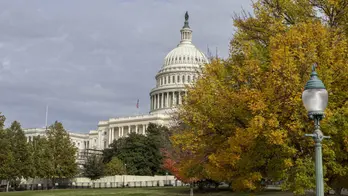Was Milton Friedman Really 'The Last Conservative?'
In 1967, Milton Friedman took a temporary leave from the University of Chicago to spend a quarter teaching at UCLA. UCLA was then jokingly called "the University of Chicago at Los Angeles" or, more simply, "Chicago West." Its economics faculty — like Chicago's — was one of the few in the country that fundamentally embraced free-market capitalism and opposed the dominant school of Keynesianism, which supported stronger government involvement in the economy.
While in Los Angeles, Friedman befriended a local businessman, Henry Salvatori, a mover and a shaker in conservative politics. One day, Salvatori invited Friedman to accompany him to a dinner at the home of California's newly elected governor, a former actor and rising conservative star who Salvatori had helped elect. His name was Ronald Reagan.
"I was delighted to find that he was not only a warm, attractive human being, but that his views on educational issues were very much in line with my own," Friedman would recall in his memoir about his first meeting with Reagan.
Over dinner, the two discussed Reagan's goal of increasing tuition costs for kids attending California's public universities, and Friedman's controversial idea for school vouchers, which would give tax dollars to parents who chose to send their kids to private schools instead of public schools. Reagan was apparently already familiar with the idea because he had read Milton Friedman's free-market manifesto, Capitalism and Freedom, which had been published five years before.
Several years after this fateful meeting, Friedman joined Governor Reagan in his statewide campaign for Proposition 1. The ballot measure was Reagan's attempt to amend the California constitution and impose a permanent cap on annual state spending. The governor and the professor flew from city to city together in a private plane, making the case that lawmakers shouldn't be able to spend like drunken sailors anymore. At one stop, a reporter asked Friedman if he would support Reagan in a future presidential bid. He answered with an enthusiastic yes.
Proposition 1 ended up failing. But a few years later, in 1978, California passed a similar ballot measure: Proposition 13. It dramatically slashed property taxes in the state. More than that, it heralded a new era of tax and spending cuts, deregulation, and "small government" politics that would spread across the nation and culminate with the election of Reagan as president in 1980. Friedman, of course, was along for the ride, serving as an important advisor and hype man for the Reagan Revolution.
Rare for any economist, with the exception of perhaps Adam Smith, Karl Marx, and John Maynard Keynes, Milton Friedman's ideas would come to shape and even define an entire era of politics and public policy. Leaders like Margaret Thatcher and Ronald Reagan closely allied themselves with this 5'2" Chicago economist who, until the 1960s, was little more than a fringe intellectual counterrevolutionary, opposed to the massive expansion of the size and scope of government during the mid-twentieth century.
In her new book, Milton Friedman: The Last Conservative, Jennifer Burns traces the life and career of this influential economist, from his humble beginnings in Rahway, New Jersey, to his worldwide renown as hero to the Right and a villain to the Left. And she reconsiders Friedman's legacy in the wake of a "bipartisan assault" against his ideas over the last decade.
The Last Conservative?
Burns admits that she selected her subtitle — The Last Conservative — with "some trepidation." For one thing, she notes, Friedman rarely referred to himself as a conservative. He tended to call himself a liberal, in the classic sense, meaning a believer in individual rights and freedom, free trade, and limited government. (Interesting, another recent book, which is about another famous free-market advocate named Friedrich Hayek, is titled Liberalism's Last Man. A sign of the times?)
But Burns dislikes calling Friedman a liberal because, in the United States, "that word has become inexorably associated with the New Deal order Friedman opposed throughout his life."
[Editor's note: This is an excerpt of Planet Money's newsletter. You can sign up here]
In Europe, and in American academic circles, Friedman has become known more technically as a "neoliberal," which is one of those highfalutin buzzwords that means different things to different people, although generally people use it to mean free-market hack. These days, neoliberalism is almost always used pejoratively. Rarely do people actually call themselves neoliberals.
But, in a 1951 essay published in a Norwegian magazine, Friedman did refer to himself as one. The essay was titled "Neo-Liberalism and its Prospects," and, in it, Friedman offered his own definition for neoliberalism.
In this essay, Friedman criticized the worldwide trend toward "collectivism" and strong government intervention in the economy, which had swept through most of the industrialized world in the mid-twentieth century. But he also criticized classical liberalism, which had been dominant in the nineteenth and early twentieth centuries. "This philosophy assigned almost no role to the state other than the maintenance of order and the enforcement of contracts," Friedman wrote of classical liberalism. "It was a negative philosophy. The state could do only harm."
Friedman proposed a new ideological path, which was neither classical liberalism nor big-government collectivism. "We have a new faith to offer," he wrote. It was a faith that embraced the individual freedom and reverence for the free market found at the heart of classical liberalism. But, unlike classical liberals, Friedman advocated for a more involved government, which would work to ensure the capitalist system ran smoothly, remained competitive, and avoided another Great Depression. "The state would police the system, establish conditions favorable to competition and prevent monopoly, provide a stable monetary framework, and relieve acute misery and distress," Friedman wrote. "The citizens would be protected against the state by the existence of a free private market; and against one another by the preservation of competition."
Whatever you want to call Friedman's ideology — neoliberalism or libertarianism or free-market fundamentalism or conservatism — it really took off in the late twentieth century, especially after the early 1970s, when a combination of high inflation and high unemployment (aka "stagflation") discredited the dominant Keynesian approach to managing the economy. Quite remarkably, in his 1967 speech as president of the American Economic Association, Friedman predicted stagflation, arguing that inflation would soon accelerate and that high inflation would commingle with high unemployment, something that many Keynesians believed could not happen. The inflation of the 1970s and early 1980s proved to be a "wrecking ball" for the old political order, in the words of Burns. And, to many, it confirmed Friedman's view of the economy.
"By the final decades of the twentieth century, Friedman's ideas helped a new political order emerge, as countries abandoned top-down economic planning in favor of market-based approaches," Burns writes. Even Democratic leaders like President Bill Clinton were at least partially embracing Friedman's free-market vision, with policies like welfare reform, financial deregulation, and free trade.
But now the pendulum seems to be swinging back. Just as stagflation helped to kill off the reign of old-school Keynesianism, the Great Financial Crisis of 2008 — and more broadly, the explosion of inequality, the stagnation of middle-class wages, and the dearth of of solid work opportunities for many lower and middle class Americans — has begun to topple the reign of neoliberalism. In recent years, we've seen a shift in both political parties, away from unswerving faith in the free market. This shift really goes to the heart of Burns' subtitle, The Last Conservative.
"In the twenty-first century, the synthesis that Friedman represented — based in free-market economics, individual liberty, and global cooperation — has cracked apart," Burns writes.
Conservatism as a brand is still, of course, very much around. Burns recognizes that. It's just that she, like many others, sees a much different brand of conservatism these days. Especially since the election of Donald Trump, the Republican party seems to be embracing an ideology that is more interventionist, isolationist, and nationalist. It has a much less libertarian flavor.
A New Republican Party?
Many of the stars in the Republican Party can sound more like New Deal Democrats or zealous nationalists than Reagan Republicans these days. Far from bowing to the altar of the invisible hand, they've been arguing for the very visible hand of the government to direct and regulate the market, restrict immigration and free trade, reinvigorate domestic manufacturing, break up companies, and even redistribute wealth.
Senator Josh Hawley crusades against corporate power, urging the government to break up monopolies and ban large mergers and acquisitions. Senator Todd Young co-sponsored a bill to restrict business use of non-compete agreements, which corporations have used to tamp down worker mobility and wages. Senator Tom Cotton proposes the government fund worker training programs — and finance them by taxing the endowments of elite private colleges.
Earlier this year, Florida Senator Marco Rubio released a book, Decades of Decadence, which blasted the "neoliberal" era for hurting working class Americans. He even praises Senator Bernie Sanders, a democratic socialist, for arguing decades ago that free-trade deals would outsource American manufacturing to places like China and Mexico and hurt American workers.
"Neoliberal economics said that America would actually gain from giving away our industry to foreign nations, because consumer products would be cheaper and American workers could give up their manufacturing jobs for supposedly more 'productive' jobs in finance and digital technology," Rubio writes. "Neoliberal foreign policy said not to worry about it; after all, the US dollar was still the world's reserve currency, and foreign nations would ally with us simply because they would become wealthier. Combined, it was a recipe for disaster. After China was admitted to the WTO, it was a disaster on the grandest scale."
But Milton Friedman Still Shapes Our World
Despite the turn against the worldview of Milton Friedman, Jennifer Burns argues that Friedman's ideas are still living and breathing all around us.
One of his primary academic contributions was to get economists and policymakers to recognize how important monetary policy is for the economy. Before Friedman, the Fed wasn't very active in trying to control inflation or boost employment. Those responsibilities fell more to the elected branches of government, which used policies like price controls and fiscal policy to stabilize the economy. Back then, Burns writes, that the Fed was "structurally neutered" and worked in "bureaucratic anonymity."
In 1963, Friedman, together with Anna Schwartz, published an incredibly influential book, A Monetary History of the United States, 1867-1960, which transformed the way economists thought about the Federal Reserve. It provided influential evidence that the Great Depression became the Great Depression because the Fed failed to step up to the plate and do its job. It let banks fail, stubbornly stayed on the gold standard, did not pump money into the system, and let the economy sink into a deflationary oblivion. Friedman and Schwartz also blamed the Fed for stoking inflation at various times in American history by, essentially, printing too much money.
Since the publication of this book, economists and policymakers have taken the role of central banks much more seriously than they did before. And institutions like the Federal Reserve have become much more vigorous in working to prevent both inflation and deflation.
True, Milton Friedman's dream for the Federal Reserve was not fully manifested. He wanted it to use the nation's money supply, as opposed to interest rates, as its primary policy instrument. The Fed experimented with that in the 1980s, and it proved to be difficult to do in practice. Friedman wanted the Fed to manage monetary policy with simple, clearly defined rules instead of leaving it to the discretion of its leaders. That idea did not end up winning the day. It's also unclear how Friedman would have felt about unconventional monetary policies adopted after his death, like Quantitative Easing.
But, Burns writes, Friedman's ideas shined a spotlight on just how important the Fed is, and fundamentally elevated the role that it (and other nations' central banks) play in the economy. Thanks largely to Friedman, Burns suggests, central banks now take center stage in economic policy.
Many other Friedman ideas are also still alive and kicking. Watch the GOP presidential primary debates, and you'll hear the candidates offer policy proposals from the Friedman playbook. Even the Trump Administration, with all its rhetorical breaks from past Republican administrations, still embraced a Friedmanesque view of the economy in important respects. Look no further than its biggest legislative accomplishment: The Tax Cuts and Jobs Act, which slashed corporate taxes and, at least partially, simplified the tax code. Trump's Secretary of Education, Betsy DeVos, also fought tooth and nail for school vouchers.
Progressives are much less likely to find inspiration in Friedman's work. His policy prescriptions are often blamed for the explosion of inequality since the 1980s. But, Burns argues, even some progressives are influenced by the ideas of Friedman. Friedman, for example, was an early proponent for a universal basic income, an idea that has gained new currency with fears that Artificial Intelligence will kill jobs. Friedman's idea for a negative income tax helped birth the popular Earned Income Tax Credit, which subsidizes the wages of low-income workers. Many progressives are also more attuned these days to the role of supply-side restrictions in pushing up prices, especially in the housing market.
"Many aspects of our contemporary world that today seem commonplace have their origins in one of Friedman's seemingly crazy ideas," Burns writes. "If you've had taxes withheld from a paycheck, planned or postponed a foreign holiday due to the exchange rate, considered the military as a career, wondered if the Federal Reserve really knows what it's doing, worked at or enrolled your child in a charter school, or gotten into an argument about the pros and cons of universal basic income, you've had a brush with Friedman."
The high tide of neoliberalism — or whatever you want to call it — may be receding. But Burns shows that the ideas of Milton Friedman are still shaping our world. Wherever you sit on the political spectrum, there's a lot to learn from this book. More than a biography of one controversial person, it's an intellectual history of twentieth century economic thought.
Disclaimer: The copyright of this article belongs to the original author. Reposting this article is solely for the purpose of information dissemination and does not constitute any investment advice. If there is any infringement, please contact us immediately. We will make corrections or deletions as necessary. Thank you.







